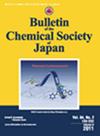Enzyme-mimetic Catalyst Architectures: The Role of Second Coordination Sphere in Catalytic Activity
IF 3.8
3区 化学
Q2 CHEMISTRY, MULTIDISCIPLINARY
引用次数: 0
Abstract
Enzymes with well-defined three-dimensional structure have in-built information for molecular organization in the near vicinity of the active sites – popularly known as enzyme architecture. Over the past few years, molecular assembly has been exploited in creating artificial enzyme or catalyst architectures. Emergent spatiotemporal structure and catalytic activity can be achieved through controlled assembly of suitable molecular building blocks. The programmed molecular assembly governed by the scheme of molecule architectonics can generate enzyme-mimetic catalyst assembly-architecture. Apart from the conventional ligand-metal interaction in the first coordination sphere of a catalyst, second coordination sphere play key role in the catalytic activity of enzymes. This review attempts to unravel the balancing act between molecular architectonics and second coordination sphere in catalyst assembly-architectures development. Judicious design and exploitation of the state-of-the-art biomimetic catalyst architectures derived from small molecules, sugars, nucleic acids, peptides, and proteins are discussed under the above-mentioned framework. Metal-coordinated molecular assembly-architectures of specific catalytic property are considered with respect to the nature of molecular assembly and experimental conditions. The concise and critical discussion provide a holistic view on the enzyme-mimetic architectures and their second coordination sphere through reductionistic approach-based on the molecular architectonics of simple and modular molecular building blocks. This review highlights the contribution of molecular architectonics and second coordination sphere theory in designing state-of-the-art catalyst assembly-architectures as enzyme-mimetics.模拟酶催化剂结构:第二配位球在催化活性中的作用
具有明确的三维结构的酶具有活性位点附近的分子组织的内在信息-通常称为酶结构。在过去的几年里,分子组装已经被用于制造人工酶或催化剂的结构。紧急的时空结构和催化活性可以通过适当的分子构建块的控制组装来实现。由分子结构方案控制的程序化分子组装可以生成模拟酶催化剂的组装结构。除了在催化剂的第一配位球中进行传统的配位作用外,第二配位球对酶的催化活性起着关键作用。本文试图揭示在催化剂组装体系结构的发展中,分子体系结构和第二配位领域之间的平衡行为。在上述框架下讨论了源自小分子、糖、核酸、肽和蛋白质的最先进的仿生催化剂结构的明智设计和开发。特定催化性能的金属配位分子组装体系结构考虑到分子组装的性质和实验条件。简明和批判性的讨论提供了一个整体的观点,对酶模拟架构和他们的第二个协调领域,通过简化的方法,基于简单和模块化的分子构建块的分子架构。本文综述了分子建筑学和第二配位球理论在设计最先进的模拟酶催化剂组装体系结构方面的贡献。
本文章由计算机程序翻译,如有差异,请以英文原文为准。
求助全文
约1分钟内获得全文
求助全文
来源期刊
CiteScore
6.40
自引率
5.00%
发文量
194
审稿时长
3-8 weeks
期刊介绍:
The Bulletin of the Chemical Society of Japan (BCSJ) is devoted to the publication of scientific research papers in the fields of Theoretical and Physical Chemistry, Analytical and Inorganic Chemistry, Organic and Biological Chemistry, and Applied and Materials Chemistry. BCSJ appears as a monthly journal online and in advance with three kinds of papers (Accounts, Articles, and Short Articles) describing original research. The purpose of BCSJ is to select and publish the most important papers with the broadest significance to the chemistry community in general. The Chemical Society of Japan hopes all visitors will notice the usefulness of our journal and the abundance of topics, and welcomes more submissions from scientists all over the world.

 求助内容:
求助内容: 应助结果提醒方式:
应助结果提醒方式:


